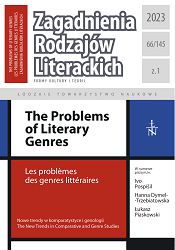
Sprawozdanie ze zdalnego seminarium „Transmedial Second-Person Narratives”
Report on the conference "Transmedial Second-Person Narratives" held on March 9, 2023 via Zoom platform.
More...We kindly inform you that, as long as the subject affiliation of our 300.000+ articles is in progress, you might get unsufficient or no results on your third level or second level search. In this case, please broaden your search criteria.

Report on the conference "Transmedial Second-Person Narratives" held on March 9, 2023 via Zoom platform.
More...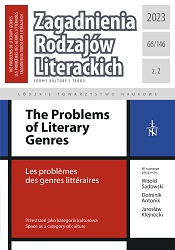
The article is an attempt to analyze the influence of Mikhail Bakhtin’s chronotope concept on the different ways of existence of time and space in two novels by Olga Tokarczuk: one of the earlier ones — Primeval and Other Times and the first one after receiving the Nobel Prize — Empuzjon. Space-time was recognized here as a key element of the writer’s work, influencing the plot structure of the works, manifesting itself simultaneously as a constructor of meanings and active formative force of values. The author, using motives that were an important element of Bakhtin’s concept of the chronotope shows that time and space play an important role in shaping the ontological and epistemological dimension of human experience. One of the main goals of the article is to show that the creative implementation of these elements makes it possible to create autonomous stories, and how space (and time) as a cultural category is used to explore the issues of identity, history, culture, as well as the mental and human emotional condition in the relationship of us and the world.
More...
The article is devoted to the category of space in adaptation studies. As the author argues, it is necessary to develop transdisciplinary tools that link formalistic and cultural approaches in comparative studies. The author proposes to use spatial properties such as center-periphery, internal-external, open-closed, as analytical tools in studies of space that can break the above divisions. As he argues, these notions should be treated in research not only as textual qualities, but also as conceptual frameworks triggering many different associations and discourses. The text that shows the benefits of using these analytical tools are Sąsiady, a collection of short stories by Adrian Markowski, and its film adaptation by Grzegorz Królikiewicz. Creating a representation of people from the social peripheries, the director makes significant changes in relation to the literary text. Królikiewicz tries to make a viewer take a different look at the social peripheries. Various formal experiments serve this purpose, above all the play with space, which is at the same time a play with social discourses. The author characterizes center-periphery, internal-external, open-closed relationships in both texts. He not only points out differences between literary and film text but shows how both media can think “about space” and think “through space.”
More...
The text deals with change in the approach to crime novels and the status of their authors from the audience’s perspective in the times of the “militia novel” present in the People’s Republic of Poland up to democratic times, after the political changes post-1989. The authors of police crime novels in the People’s Republic of Poland very often hid their personal details under pseudonyms - whether out of shame or due to the protection of personal dignity. In democratic times they began to publish under their own names, because the creation of detective or thriller novels was no longer subject to political censorship, nor was it marked a sign of alleged support for the communist regime. The possibilities of the free market and the freedom of expression in democratic Poland after 1989 enabled the authors of crime and thriller novels to gain both real popularity and fair earnings. The most recognizable and popular authors of crime and thriller literature have become not only the inhabitants of the collective imagination, but also the objects of gossip, sensational news (of course not always reliable), as well as important people within mass culture. The article discusses - in general - both the shape of the militia novel from the times of the People’s Republic of Poland and its direction of development - also generally - of contemporary crime fiction in Poland, paying attention to both its specific or original aspects (e.g. the retro-crime subgenre, which seems to be a kind of Polish specialty) as well as inspirations with crime stories - mainly - European (especially the Scandinavian model of socially engaged crime fiction). In conclusion, the text outlines the evolution of Polish crime thriller prose from the crude model of a militia novel to a full-fledged and bloody model of a contemporary crime thriller set in a democratic and free-market world.
More...
Review of: Słownik kultury literackiej Łodzi do 1939 roku, red. Katarzyna Badowska, Tomasz Cieślak, Dariusz Dekiert, Karolina Kołodziej, Monika Kucner, Krystyna Pietrych, Krystyna Radziszewska, Anna Warda, Ewa Wiatr, Wydawnictwo Uniwersytetu Łódzkiego, Łódź 2022, ss. 460
More...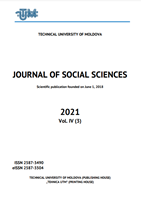
The purpose of present research is to emphasize the way in which literature contributes to the needs of new students in their social interaction. The key factors that we focused on span the entire scope of studying a foreign language through literature. Thus, the methods we suggest for this refer to: motivating students to read, using poems, creating a play in class, using dramatic texts and narratives. It has been constantly recognized that the new European context influences the new generation of students in their way of perceiving the world with everything this implies. Spanish classes are essential in the process of shaping the character of a young person as a social person. The development of thinking and cultural awareness can be achieved through the use of an appropriate methodology, in addition to addressing all fields of a foreign language: pronunciation, literature, speaking, listening, reading, vocabulary, written comprehension and a variety of means.
More...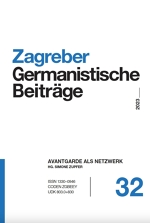
The essay offers a (re)construction of an avant-garde network consisting of imagism, expressionism, and surrealism in literature and art. It proposes a reassessment of Ezra Pound’s and André Breton’s concepts of the poetic image, and compares them to their counterpart in the writing and poetry of Croatian expressionist writer Antun Branko Šimić. Through this reconstruction of one node in the avant-garde network, the paper proposes a theory of avant-garde as a twofold structure of de-figuration and transfiguration, which performs the role of re-figuring reality. This proposal solves a principal tension in Peter Bürger’s argument expounded in Theorie der Avantgarde.
More...
Für die Avantgardeforschung ist Maria Lazars Die Vergiftung (1920) als Roman von Interesse, der sich im Grenzbereich von voravantgardistischem Vitalismus und spätexpressionistischer Avantgarde positioniert. Diese Zwischenstellung spiegelt sich auch in den Geruchsmotiven des Textes, die im Anschluss an eine Skizze der Bedeutungen ambivalenter Gerüche in Moderne und Avantgarde (1) detailliert herausgearbeitet werden (2). Die wenigen Dokumente zum erfolglosen Roman der gut vernetzten Autorin zeigen, dass seine Rezeption durch die Geruchsmotive mitgeprägt wurde. Das Potential von Lazars vitalistischer Geruchskultur kommt erst nach ihrem Durchbruch in der Neuen Sachlichkeit zur Geltung (3).
More...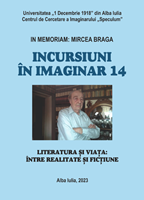
Reality and fiction build a binary which shared the fate of dualist thinking in general in the postmodernist age, dominated by deconstruction. The climactic point was probably reached by the fabrication of lens which magnify reality. The fabrication of virtual reality lens was meant to augment reality, virtual reality meaning less or a deformed reality show. Science and technology have thus reified the philosophical battle over positivist taxonomies and classifications that first came under the philosophical onslaught of Søren Kierkegaard and Friedrich Nietzsche. The “either/ or” dichotomy of the former ended up in the latter’s “beyond”, which, in quantum language, is a superposition of opposite states. Although the bulk of fantasy and science-fiction still capitalizes on the distinct ontologies of reality and fiction, the literature of late modernity (modernism and postmodernism) speculated on an ontological hybrid bridging the ontological gap between the two of them. Such are the modernist novel, “Isabel and the Devil’s Waters” by Mircea Eliade, and the postmodernist story, “Schrödinger’s Cat,” by Ursula K. Le Guin read in the key of an ontological poetics in the present paper.
More...
The story is part of the psychological fantasy, the limit situations in which the characters fall due to an imbalance between culture, related to their inner or personal life, and respectively civilization, social life, the external world in which the characters evolve. The innovative element of the story emerges from the balanced ratio between the real and bookish, by recreating a legend in a real situation, by adopting the theory of personality migration. The psyche of the heroes is marked by unusual experiences that lead to the modification of their ways of perception. In Magical Love, Vasile Voiculescu presents the psychoerotic mechanism caused by the complex play of the poet's imagination and intelligence, the character in the story, an erudite with a scientific mentality, based on logic, wanting to write a replica of Goethe'swork, Faust, with roles reversed. His intention was to reverse the pact with the devil in Faust, switching the action to heaven and overturning the senses. However, the effect will be totally unexpected: she will not have a pure and loving Margaret, but a witch-Margarita, a real female Mephisto. The hero of the story realizes that the condition he perceives is an obsession that reaches the level of personality substitution, a psychological phenomenon that occurs under the effect of the substitution in imagination of the feminine ideal. The fact that the tempted woman accumulates attributes of cerebrality demonstrates Voiculescu's confidence in a possible restoration of androgynous perfection. Voiculescu's intention to demystify the supernatural element from folklore traditions, resorting to psychology, is evident. The events related are subject to a process of derealization, the author distancing himself from the action by multiplying the points of view, the perception of the facts by the large number of narrators. The first narrator, serving as a mere narrative convention, recedes to make way for the poet, the doctor, and the painter. The triggering element that has an effect on the poet is the discussion about the folkloric influence of the sea, the result being the recollection of an incident from his youth, when he had accompanied a friend, a collector of folklore, to an isolated mountain village. The description of the events is direct and sprinkled with many details, their interpretation depending on the attitude of the storyteller. Although there are signs of the unnatural and suggestions of magic, the narrator tries to find a logical explanation, precisely to discourage a perception of a secondary reality, visibly belonging to the occult, not surprising in the cultural psychology of the world of the rather deserted village, without social life, without church and priest. Vasile Voiculescu's story does not focus on the events and situations, but on the way of perception of the female character by the male characters.
More...
The paper „Real and Imaginary names in the Romanian fantastic fairy tales. On names originating from plat appellation” proposes the exploration of the anthroponymy of the genre: on the one hand, from the perspective of the onomastic elements that belong to the extralinguistic reality, and on the other hand, from the perspective of the innovations proposed by popular creators regarding the denomination. As we know, literary name research is a complex undertaking in which the reasoning for the creator’s choice of names must be considered. Therefore, we must explore, examine, and treat the "real" names in fairy tales with the same care as the "imaginary" names, which are generally more enticing and attractive to both the reader/listener and the critic. In this paper, the "real" names are considered from a linguistic perspective, taking also into account their use in the textual source, while the types of "imaginary" name categories contained in the fairy-tale are illustrated in terms of denominator creativity. Our inquiry also discusses the names based on the plant appellation, attempting to show their significance in the fairy-tale structure.
More...
The present work proposes an applied analysis, by bringing together the Romanian literary avant-garde with the European artistic one, a reunion represented by the text Emil Gayk, a text written by the precursor of the Romanian avant-garde, Urmuz, and the painting Barbarii (The Barbarians) by the German surrealist painter Max Ernst. Both works are specifically related to the First World War, a traumatic experience that leads to specific poetics of avant-garde and modernity, that of the crisis of human representation. Thus, we will pursue a comparative, but also interdisciplinary approach, the selected literary text being subjected to a hermeneutic approach, through a close reading in close connection with the real context of the beginning of the 20th century, while Max Ernst's work will be subjected to an aesthetic analysis, its component elements also reflecting the tragedy and tension of the First World War. The two works reflect, through specific techniques, predominantly surrealist (or, in any case, from the general sphere of the avant-garde), the way in which the modern and avantgarde artist feels this tension caused by the war, so that by the experience of the conflagration, lived directly or indirectly by to the two representatives of the avant-garde, an alienated and reified world is reconstructed, a world of the body crisis, of the sick mind. The irrationality and absurdity of war will be reflected in the avant-garde works of the two representatives, configuring a strong visual dimension and thus a spectacular absurdity of the human body, inspired by the front-line experiences of the European avant-garde artists. Dehumanization and the monstrous, the grotesque, the hybrid, the cadaver, the incongruity of anatomical elements, behavioral deviations and irrational acts, zoomorphism or the mechanization of the human are recurring themes of avant-garde works that highlight this cause-effect relationship between the trauma of war, with the real lived experience, and their mirroring in literary texts (by Romanian avant-garde representatives, such as Urmuz, Tristan Tzara, Ilarie Voronca, etc.) or in paintings (through representatives of modern plastic art and the avant-garde, such as George Grosz, Otto Dix, Max Ernst, etc.). Considering the common experience surrounding the First World War, a moment of amplification of the artistic crisis at the beginning of the 20th century, the two proposed works present a new vision of the alienated modern human, a crisis of the human representation generated by the anxieties and trauma of the war, through which the individual becomes a composite, deformed, sickly creature, made up of heterogeneous elements, a melting point. In this way, those elements of vision, specific to avant-gardes and modernity (as a generic term), which contribute to mirroring the experience of war, will be analyzed. Both works are based on a modern aesthetic vision, nuanced on the basis of avant-garde formulas, considering the themes and motifs they encompass, the style, the construction of the characters, the images and, thus, the predominantly visual dimension, respectively the way in which the narrative discourse is constructed in the case of the text Emil Gayk by Urmuz and the way in which the techniques and images specific to surrealism become complementary in the painting Barbarii (The Barbarians) by Max Ernst. Through an interdisciplinary approach, we can observe how, both in literature and in art, this new perspective on “the human” is proposed, in the context of the crisis of their representation.
More...
After 1848, the area inhabited by Romanians outside the Carpathian Arc underwent profound mental and social changes, which culminated in 1859 with the Little Union of Moldova and Wallachia. However, the consciousness of race and language were not realities that manifested themselves only in these Romanian provinces, Transylvania being united in national feeling with the other Romanians, despite the special historical conditions in which it is located. This consciousness of Romanianness would eventually lead to the Great Union in 1918 in Alba Iulia. One of the promoters of national consciousness was Ion Pop Reteganul, whose activity was also carried out in literary history, which he approached from a moderately critical perspective. His teacher training left its mark on his writing because he tried to bring out always in evidence the moralizing side of any text he brought to his reader. In its pages of historical-literary journalism, this moralizing side is doubled by the admiration for the personalities it presents, their activity, and their creation, which touched on topics necessary for the growth of a healthy Romanian community as a mentality and recognition of its value.
More...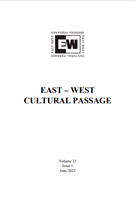
This article explores the political dimension of Junot Díaz’s work, focusing on the figure of the dictator as depicted in the footnotes to The Brief Wondrous Life of Oscar Wao, in an attempt to analyze his view of the “dangers of dictatorship” in both literature and politics and to prove that the political attitudes of writers influence the way their literature “does” politics. Thus, a thorough analysis of the footnotes exposes The Brief Wondrous Life of Oscar Wao as a story about a nerd in New Jersey “dictated” by the narrator, which is challenged by the story of Rafael Leonidas Trujillo who “dictated” the recent history of the Dominican Republic.
More...
This article sets out to explore the ambiguities and points of rupture in the lyrical works of one of the best-known Irish poets of the last fifty years, Eavan Boland. I intend to zoom in on poetic sequences where the text does not flow seamlessly and will try to find possible explanations for these ruptures, illuminating, in the process, the merits of a poet who has tried to recuperate the image of the Irish woman, saving it from stereotypes and cliches. However, I will also shed light on how Boland herself falls prey to more or less the same stereotypes. What the article ultimately does is raise questions which are still waiting for answers.
More...
This article examines the representation of the connection between religious beliefs and the natural environment around sacred places in God Was African by Nkemngong Nkengasong and Chronicles of a Corpse Bearer by Cyrus Mistry. Comparing the eco-cycle around Zoroastrian Fire Temples, the Towers of Silence in Bombay and the shrines of Fuondem and other gods in Lewoh traditional religion, this article argues that the inter-connectivity between these ParsiBangwa religions reveals that gods reside in our immediate environment and only our eco-politics can preserve this supernatural connection. Using ecocriticism, therefore, I contend that the Parsis in India and the Bangwa in Lebialem revere and protect natural abodes of the gods like earth, water, hills, valleys, forests and fire against the devastating environmental crises heralded by the modernist backlash. The modern transformation of these sacred places into sources of generating renewable and artificial energies accounts for the different physical and ideological conflicts that abound in the two novels. As such, by protecting the different forms of life that inhabit these sacred places, this article concludes that Nkengasong’s and Mistry’s eco-poetical language and style in God Was African and Chronicles of a Corpse Bearer reflect Lewoh traditional religion, Zoroastrianismandtheenvironment, participating in the Afro-Oriental artistic crusadeforbiophilia and environmentally friendly belief systems.
More...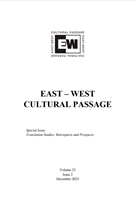
Translation and translators are emerging as powerful catalysts for promoting vibrant cross-cultural interaction among individuals from different backgrounds. Commonly perceived as the process of converting content from one language to another, translation is a nuanced and multifaceted endeavor that transcends mere linguistic conversion. Translators act as adept mediators, deftly navigating the intricate web of diverse texts and cultures while shaping their uniquely insightful perspectives. This article explores the rich historical dimensions of translation, highlighting its deep connections to philosophical beliefs and socio-political dynamics. It also aims to enhance our understanding of the complex nature of this practice by dissecting various dichotomies in translation studies, including contrasting philosophical views of translation and divergent approaches to the art of translation. In today’s interconnected world, the role of the translator has become increasingly indispensable, underscoring that translation goes beyond mere words; it serves as a mirror that reflects the everevolving globalized landscape. To chart a path forward, we must recognize the importance of revisiting the past, drawing wisdom from history, and gaining valuable insights for the future.
More...
“If you translate long into the machine, the machine translates back into you,” is one of the issues the present article strives to establish and explore qualitatively. I intend to examine the effectiveness and efficiency of machine-assisted translations of significant literary works from a hermeneutical perspective. Essentially, I analyse the output of automated translation platforms such as Google Translate and compare them to human translation. This investigation is valuable in determining whether translators should exercise caution when utilizing translation platforms for culturally rich literary works. Additionally, the article scrutinizes the localisation, cultural, and grammatical coherence of Homer’s The Iliad translated from English to Romanian using the Google Translate platform. The human translations used are rendered into English and Romanian from Greek. As Homer’s Greek remains incomprehensible to the translation platform, we employ a secondary translation technique for a tertiary machine-assisted output. Nonetheless, this approach highlights the serious pitfalls of using translation platforms haphazardly in translation work. This analysis will show how awareness of the machine’s imperfect translation capabilities may, in turn, enhance the human translator’s awareness of what works while translating with the help of a translation application.
More...
The present article sets out to investigate the rendering of cultural elements in the process of poetry translation, an undertaking that is a strenuous one, given the constraints of form. It looks into and illustrates the many layers of Seamus Heaney’s poetry, pointing at the profusion of allusions to cultural aspects that are embedded in the texts, and that ask the translator to decide whether to “foreignize” or “domesticate” the text. These extratextual features that a translator needs to consider are imbricated with the various textual elements, generating effects that are difficult to replicate in translation, making similarity of effect all the more difficult to achieve.
More...
The present article aims at presenting features specific to translating dramatic texts, the peculiarities of the genre and how these can be tackled in the process of translating. The case study comprises an analysis of the translation and adaptation for radio broadcasting of Samuel Beckett’s Krapp’s Last Tape. Theoreticians have constantly pointed out that drama translators should always focus on the performability, speakability, gestural and aural dimensions of the text, given that the final product has to be playable in front of an audience. The ultimate goal is to obtain a text that sounds natural and is easily understood, where the aural and gestural dimensions fit and work together. In order to make the translated text performable in another medium, certain changes are necessary. In the present case study – adapting a play for radio broadcasting –, everything visual becomes aural, and in this process stage directions are the most challenging to be handled. Adding, omitting or rephrasing are options that the translator has to constantly consider.
More...